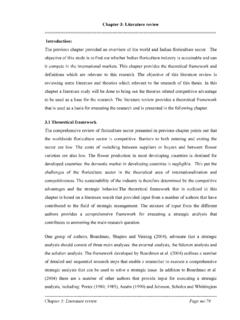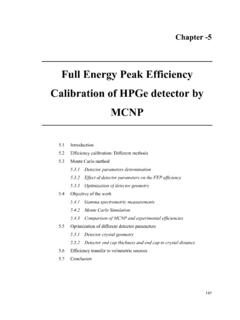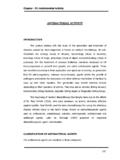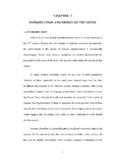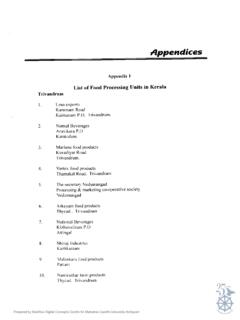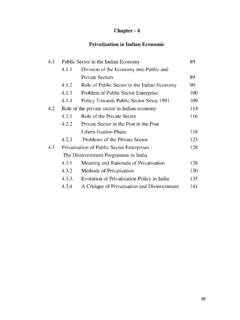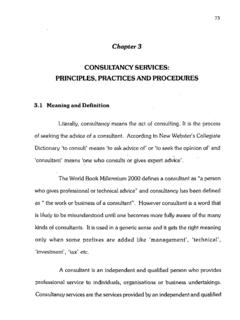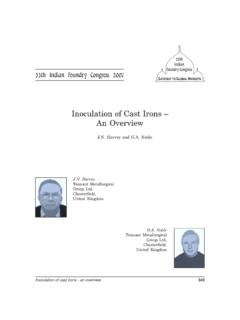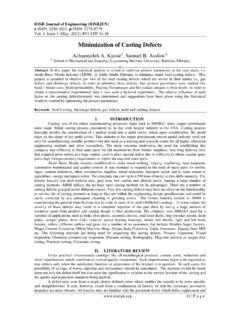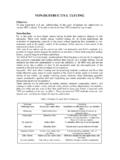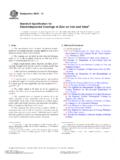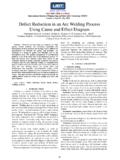Transcription of CHAPTER-I INTRODUCTION 1.1 DEFINITION OF WELDING
1 1 CHAPTER-I INTRODUCTION DEFINITION OF WELDING WELDING is the process of joining together two pieces of metal so that bonding takes place at their original boundary surfaces . When two parts to be joined are melted together, heat or pressure or both is applied and with or without added metal for formation of metallic bond. NEED FOR WELDING With ever increasing demand for both high production rates and high precision, fully mechanized or automated WELDING processes have taken a prominent place in the WELDING field. The rate at which automation is being introduced into WELDING process is astonishing and it may be expected that by the end of this century more automated machines than men in WELDING fabrication units will be found. In addition, computers play critical role in running the automated WELDING processes and the commands given by the computer will be taken from the programs, which in turn, need algorithms of the WELDING variables in the form of mathematical equations.
2 To make effective use of the automated systems it is essential that a high degree of confidence be achieved in predicting the weld parameters to attain the desired mechanical strength in welded joints. 2 To develop mathematical models to accurately predict the weld strength to be fed to the automated WELDING systems has become more essential. CLASSIFICATION OF WELDING PROCESSES There are many types of WELDING techniques used to join metals. The WELDING processes differ in the manner in which temperature and pressure are combined and achieved. The WELDING process is divided into two major categories: Plastic WELDING or Pressure WELDING and Fusion WELDING or Non-Pressure WELDING . Plastic WELDING or Pressure WELDING : When the metal piece acquires plastic state on heating, external pressure is applied. In this process, externally applied forces play an important role in the bonding operation.
3 A group of WELDING processes which produces coalescence at temperatures essentially below the melting point of the base materials being joined without the addition of a filler metal is Pressure WELDING Process. Without melting the base metal, due to temperature, time and pressure coalescence is produced. Some of the very oldest processes are included in solid state WELDING process. The advantage of this process is the base metal does not melt and hence the original properties are retained with the metals being joined. 3 Fusion WELDING or Non-Pressure WELDING : The material at the joint is heated to a molten state and allowed to solidify. In this process the joining operation involves melting and solidification and any external forces applied to the system do not play an active role in producing coalescence. Usually fusion WELDING uses a filler material to ensure that the joint is filled.
4 All fusion WELDING processes have three requirements: Heat, Shielding and Filler material. TYPES OF WELDING WELDING process can also be classified as follows: 1. Gas WELDING Oxy Acetylene WELDING Oxy Hydrogen WELDING Pressure Gas WELDING 2. Arc WELDING Carbon Arc WELDING Shield Metal Arc WELDING Submerged Arc WELDING Metal Inert Gas WELDING Tungsten Inert Gas WELDING Electro Slag WELDING Plasma Arc WELDING 4 3. Resistance WELDING Spot WELDING Flash WELDING Resistance Butt WELDING Seam WELDING 4. Solid State WELDING Forge WELDING Cold WELDING Friction WELDING Explosive WELDING Diffusion WELDING Ultrasonic WELDING 5. Thermo-Chemical WELDING Thermit WELDING Atomic H2 WELDING 6. Radiant Energy WELDING Electron Beam WELDING Laser WELDING 5 WELDING OF DIFFERENT MATERIALS The most available metal in the earth s crust is aluminum whereas, steel is the most used metal.
5 In majority of cases aluminum alloys are replacing steels in industrial applications. Aluminum alloys have low density nearly one third when compared to steels. Some of these materials are allowing for a significant reduction of weight when compared with structural steels. Aluminum alloys are important for the fabrication of components and structures which require high strength, low weight or electric current carrying capabilities to meet their service requirements. The aluminum alloys can resist the oxidation process, corrosion by water and salt, which steel cannot. The most desirable properties of aluminum and its alloys are the light weight, appearance, ability for fabrication, strength and corrosion resistance and hence it is used for wide variety of applications. When used in aerospace, rail and road vehicles these attributes enable energy efficient operation. In the aerospace applications, materials with high strength-to-weight ratio are required such as aluminum alloys.
6 The production of components of aluminum alloys is not very complex; but joining of these materials can sometimes cause serious problems. Among all aluminum alloys, 6 XXX plays a major role in the aerospace industry. They are widely used in the aerospace applications because it has good formability, weldability, machinability, corrosion resistance and good strength when compared to 6 other series of aluminum alloys. Hence these alloys are chosen in this work for FSW process. defects in WELDING The lack of training to the operator or careless application of WELDING technologies may cause discontinuities in WELDING . In aluminum joints obtained by fusion WELDING , the defects such as porosity, slag inclusion, solidification cracks etc., are observed and these defects deteriorates the weld quality and joint properties. Common weld defects found in welded joints: These defects may result in sudden failures which are unexpected as they give rise to stress intensities.
7 The common weld defects include i. Porosity ii. Lack of fusion iii. Inclusions iv. Cracking v. Undercut vi. Lamellar tearing i. Porosity Porosity occurs, when the solidifying weld metal has gases trapped in it. The presence of porosity in most of the welded joints is due to dirt on the surface of the metal to be welded or damp consumables. 7 It is found in the shape of sphere or as elongated pockets. The region of distribution of the porosity is random and sometimes it is more concentrated in a certain region. By storing all the consumables in dry conditions and degreasing and cleaning the surface before WELDING , porosity can be avoided. ii. Lack of Fusion Due to too little input or too slow traverse of the WELDING torch, lack of fusion arises. By increasing the temperature, by properly cleaning the weld surface before WELDING and by selecting the appropriate joint design and electrodes, a better weld can be obtained.
8 On extending the fusion zone to the thickness of the joints fully, a good quality joint can be obtained. iii. Inclusions Due to the trapping of the oxides, fluxes and electrode coating materials in the weld zone the inclusions are occurred. Inclusions occur while joining thick plates in several runs using flux cored or flux coated rods and the slag covering a run is not totally removed after every run and before the next run starts. By maintaining a clean surface before the run is started, providing sufficient space for the molten weld metal between the pieces to be joined, the inclusions can be prevented. 8 iv. Cracking Due to thermal shrinkage, strain at the time of phase change, cracks may occur in various directions and in various locations in the weld area. Due to poor design and inappropriate procedure of joining high residual stresses, cracking is observed. A stage-wise pre-heating process and stage-wise slow cooling will prevent such type of cracks.
9 This can greatly increase the cost of welded joints. Cracks are classified as hot cracking and hydrogen induced cracking. A schematic diagram of centerline crack is shown below fig. Fig. Schematic diagram of centerline crack The cracking can be minimized by preferring fillers with low carbon and low impurity levels. The solidification cracking can be avoided by reducing the gaps and cleaning the surface before WELDING . v. Undercutting The undercut is caused due to incorrect settings or using improper procedure. Undercutting can be detected by a naked eye and the excess penetration can be visually detected. 9 vi. Lamellar Tearing Due to non metallic inclusions, the lamellar tearing occurs through the thickness direction. This is more evidently found in rolled plates. As the fusion boundary is parallel to the rolling plane in T and corner joints, the lamellar tearing occur. By redesigning the joint and by buttering the weld area with ductile material, the lamellar tearing can be minimized.
10 ALUMINUM ALLOYS DESIGNATION CRITERIA Based on the ability to respond to thermal and mechanical treatment, the aluminum alloys are characterized into number of groups. Aluminum alloys may be divided into two broad classes: Cast and Wrought products. These two classes can be further subdivided into families of alloys based on chemical composition and finally on temper designation. To identify the condition of the alloy, the heat treatment condition, the amount of cold work it has undergone the temper designation is used. Among the many methods available to identify the alloy and its conditions, the numeric method CEN (European Committee for Standardization) is used as standard in which four digits are used to identify the wrought alloys and five digits for the cast alloys. 10 Alloying Elements Copper, silicon, lithium, zinc, magnesium and manganese are the principal alloying elements in addition to titanium, chromium, scandium and zirconium which are available in small quantities to achieve some specific properties.
